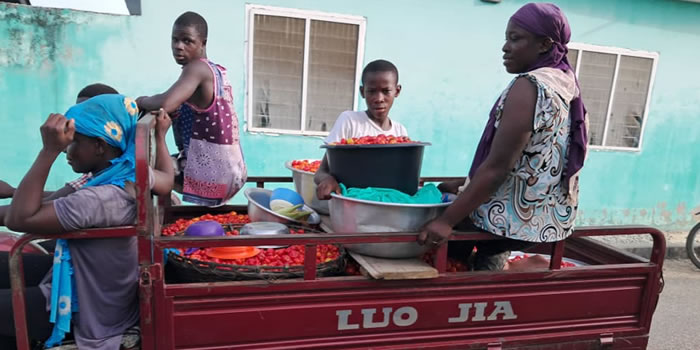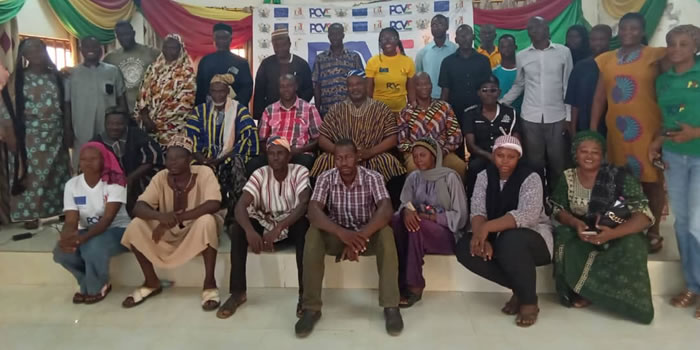

Bathing and Toilet Facilities
Sanitation and toilet facilities
An efficient and hygienic method of human waste disposal available in a dwelling unit is a critical indicator of the sanitary condition of the unit and is an indirect measure of the socioeconomic status of a household. Table 8.11 shows that four main types of toilet facilities are reported in the 2010 PHC in Kumbungu District. Eighty two percent of the households in the district reported that they have no toilet facilities (bush/beach/field), seven percent reported that they use Kumasi Ventilated Improved Pit (KVIP), six percent of households use public toilet and five percent use pit latrines. Households who use WC or Bucket/Pan reported a cumulative proportion of less than one percent.
This implies that, majority of households largely resort to open defecation (widely also known as “free range”) where persons attend to nature’s call in the bush/beach or fields.
Sanitation and bathing facilities
Bathing facilities available in dwelling units can be categorized primarily into four main types: bathroom for exclusive use, shared bathroom in the same house, shared open bathing cubicle and others.
The households who shared separate bathroom in the same house recorded the highest proportion of 51 percent, followed by households who exclusively use their own bathrooms (23%). Thirteen percent of households use shared open cubicles to bath. Less than 1 percent of households reported to use bathrooms in other houses and river/pond/lake/dam to bath. A significant percentage of households (5%) reported that they use an open space around their houses to bath.
Method of Waste Disposal
One of the intractable challenges of both urban and rural areas in Ghana is adopting modern and hygienic waste disposal systems. Acceptable waste management helps to prevent the incidence and spread of some types of infections and improves the quality of the environment. 8.9.1 Liquid waste disposal Table 8.12 shows information on method of solid and liquid waste disposal by type of locality. Among the methods of liquid waste disposal in the district are; throwing either onto a compound, onto the street or any available space outside the house. With liquid waste disposal in the district, as high as 64 percent of households throw their liquid waste onto the street/outside, 24 percent throw in the compound and seven percent throw liquid waste through drainage into a pit (soak away).
The least proportion (1%) was recorded for households who throw their liquid waste into the gutter and one percent of households throw them through sewage systems. This depicts a district with little or no sewage systems. 8.9.2 Solid waste disposal The main method of rubbish disposal by households in the district is public dump (open space) with a high proportion of 56 percent of households practicing this type of solid waste disposal.
Fifteen percent of households dump their rubbish indiscriminately and 12 percent who also burn their rubbish. Only two percent of households dump their rubbish in public dump (container). 1 No urban communities in the district according to 2010 PHC 58 Unfortunately, of all the various forms of solid waste generated by households in the district, only seven percent reported that their solid waste is collected. This probably could be as a result ineffectiveness or poor supervision of private waste management firm contracted by the district assembly to manage solid waste in the district.
Sources of water for households Water is an essential part of life.
It is in this regard that the UN Millennium Development Goal Seven aims at reducing half the people without sustainable access to safe drinking water by 2015 based on the 1990 levels. Table 8.9 presents information on sources of drinking water for households and water for other domestic use.
About 27.6 and 26.7 percent of households in the district drink from Dugout/Pond/Lake/Dam/Canal and Borehole/Pump/Tube well respectively. About 19.9 percent get their drinking water from Public tap/Standpipes and 4.3 percent have their main source of drinking water being pipe-borne inside or outside their dwellings. This is in spite of the fact that the district houses the only major water treatment plant in the region (Dalun water treatment plant).
River/stream and Protected well recorded 11.3 and 5.2 percent respectively. For source of water for other domestic purposes, 32.3 and 22.9 percent reported that they get water from Dugout/Pond/Lake/Dam/Canal and Bore-hole/Pump/Tube well respectively. Also, 233 households representing 5.6 percent reported that their water for other domestic use come from pipe-borne inside and outside of their dwellings. 55 Table 8.9: Main source of water for drinking and other domestic purposes.
Date Created : 11/21/2017 6:19:54 AM










 facebook
facebook
 twitter
twitter
 Youtube
Youtube
 +233 593 831 280
+233 593 831 280 0800 430 430
0800 430 430 GPS: GE-231-4383
GPS: GE-231-4383 info@ghanadistricts.com
info@ghanadistricts.com Box GP1044, Accra, Ghana
Box GP1044, Accra, Ghana